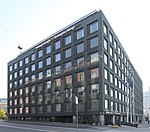Kamppi metro station

Kamppi metro station (Finnish: Kampin metroasema; Swedish: Kampens metrostation) is a station on the Helsinki Metro. In addition to serving the area around Kamppi in central Helsinki, the station is integrated with the Kamppi Center bus terminal and shopping complex. Kamppi is served by both lines M1 and M2. The station was opened on 1 March 1983, designed by Eero Hyvämäki, Jukka Karhunen, and Risto Parkkinen. It is located 1.2 kilometres (0.75 mi) from the Ruoholahti metro station, and 0.5 kilometres (0.31 mi) from the Central Railway Station. The station is the deepest of the Helsinki Metro stations, at a depth of 31 metres (102 ft) below ground level and 15 metres (49 ft) below sea level. It was built with a secondary platform located perpendicularly under the one in use, reserved for a future metro extension. Like other underground metro stations in Helsinki, Kamppi metro station was designed to also serve as a bomb shelter.A new eastern entrance, connecting directly to Kamppi Center, was opened on 2 June 2005.
Excerpt from the Wikipedia article Kamppi metro station (License: CC BY-SA 3.0, Authors, Images).Kamppi metro station
Urho Kekkosen katu, Helsinki Kamppi (Southern major district)
Geographical coordinates (GPS) Address Phone number Website Nearby Places Show on map
Geographical coordinates (GPS)
| Latitude | Longitude |
|---|---|
| N 60.168888888889 ° | E 24.931944444444 ° |
Address
Kampin keskus
Urho Kekkosen katu 1
00100 Helsinki, Kamppi (Southern major district)
Finland
Open on Google Maps








